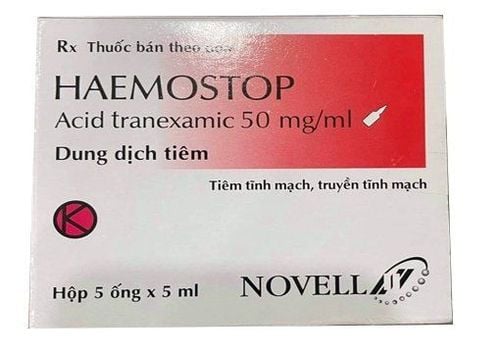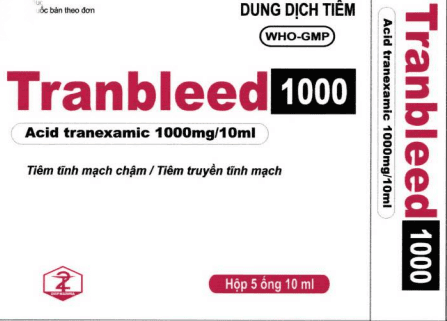This is an automatically translated article.
Antisamin is indicated in the treatment of bleeding due to various causes. So how is Antisamine used? The following article will provide necessary information about the effects and precautions when using this drug.
1. What are the effects of Antisamin?
Antisamin medicine contains the main ingredient Tranexamic Acid 250mg and excipients just enough provided by the manufacturer. Antisamin is indicated for treatment in the following cases:
Abnormal bleeding during and after surgery, obstetric and gynecological diseases (such as polymenorrhoea), diseases of the genitourinary tract (prostate bleeding) ). Hemorrhage is caused by many different causes. Hemolytic disease due to pulmonary tuberculosis , renal bleeding , nosebleed . On the other hand, Antisamin is contraindicated in the following cases:
Allergy to active ingredient Tranexamic or other excipients in the composition of the drug. Being treated for thrombosis. Cases of central nervous system surgery, central nervous system bleeding and subarachnoid bleeding or other cases of brain bleeding.
2. Dosage and how to use Antisamin
2.1. How to use Antisamin is prepared in the form of a solution for injection, administered intravenously. The drug should not be mixed with solutions containing penicillin or with blood for transfusion.
2.2. Dosage The following is the recommended dose of Antisamine:
Usual dose: Intravenous: 5-10 ml (100mg/ml) or 0.5-1g (10-15mg/kg), take from 2 - 3 times/24 hours. Administer intravenously slowly, do not inject more than 1ml/min. In case of special treatment: Systemic fibrinolysis: 10ml (100mg/ml), intravenous injection 3-4 times/24 hours. Prostatectomy procedure: used at a dose of 5-10ml (100mg/ml), during surgery, intravenously 2-3 times/24 hours with the above dose in the first 3 days after surgery. Dental surgery for patients with bleeding organs: Use Antisamin right before surgery with an intravenous dose of 10mg/kg body weight. After surgery, use at a dose of 25mg/kg body weight in the form of tablets, once every 24 hours, continuously for 6-8 days. Patients with renal impairment: It is necessary to adjust the dose of Antisamine based on the specific serum creatinine concentration as follows: Creatinine concentration from 120 to 250mmol/l: use at a dose of 10mg/kg intravenously twice a day. Creatinine concentration from 250 - 500mmol/l: used at a dose of 10mg/kg intravenously once a day. Creatinine levels above 500mmol/l: 5mg/kg IV once a day or 100mg/kg every 48 hours. When the drug overdose, patients often have symptoms such as nausea, vomiting, orthostatic hypotension. It is necessary to notify the treating doctor immediately for timely intervention if the condition worsens. The patient can be induced vomiting, gastric lavage and activated charcoal to remove the drug from the body. Fluids should be added to promote renal excretion and other measures should be used for symptomatic and supportive treatment.
3. Antisamine side effects
Doctors always consider between the benefits that Antisamin brings to the patient and the possible risk of side effects to prescribe the appropriate medication. Patients should follow the doctor's instructions to avoid unwanted effects. Some side effects may occur when taking the drug as follows:
Digestive disturbances such as nausea, vomiting, diarrhea may occur but disappear when the patient reduces the daily dose. Dizziness, low blood pressure with rapid intravenous injection, so fast intravenous injection should not be given at a rate of 1ml/min. Changes in color perception rarely occur, in which case the patient should stop taking the drug. Thromboembolism, convulsions, allergic skin reactions. In addition, you may also experience some other symptoms while taking Antisamin drugs that have not been studied. So to be on the safe side, contact your doctor immediately if you have any unusual symptoms.
4. Antisamine drug interactions
Tell your doctor about all the medicines you are using such as prescription drugs, over-the-counter drugs, functional foods, herbs... to avoid interactions that occur when taking a combination of drugs in treatment process.
The following are some drugs that have the potential to interact with Antisamine drugs when used in combination as follows:
Avoid using the combination of Antisamine and Estrogen because there is a greater risk of thrombosis. Caution should be exercised when this drug is co-administered with other hemostatic agents.
5. Some notes when taking Antisamin
Here are some notes when taking Antisamin to help achieve its effectiveness as well as reduce the risk of side effects:
People with a history of blood clots should not take Antisamin unless they are also being treated with anti-inflammatory drugs. bronze. Patients with disseminated intravascular coagulation bleeding should not be treated with antisamines unless the disease is primarily due to a disorder of the fibrinolysis mechanism. It is necessary to appoint additional use of Heparin in a carefully considered dose. Antisamin should not be used in patients with renal failure due to the risk of accumulation of Tranexamic acid. When Antisamine is used in patients with hematuria from the upper urinary tract, there is often a risk of obstruction in the kidney. Antisamines should not be administered to pregnant women during the first months of pregnancy, as adverse effects on the fetus have been reported. Use this medicine in pregnancy only when strictly indicated and when other alternative therapy cannot be used. Since the drug is excreted in human milk, breast-feeding should be discontinued while taking this drug to avoid any risk to the nursing infant. Above is information about uses, dosage and precautions when using Antisamine. To ensure safety for your health and maximize the effectiveness of your treatment, you need to take Antisamin exactly as directed by your doctor. Store Antisamin at room temperature, avoid direct light on the medicine.
Please dial HOTLINE for more information or register for an appointment HERE. Download MyVinmec app to make appointments faster and to manage your bookings easily.













